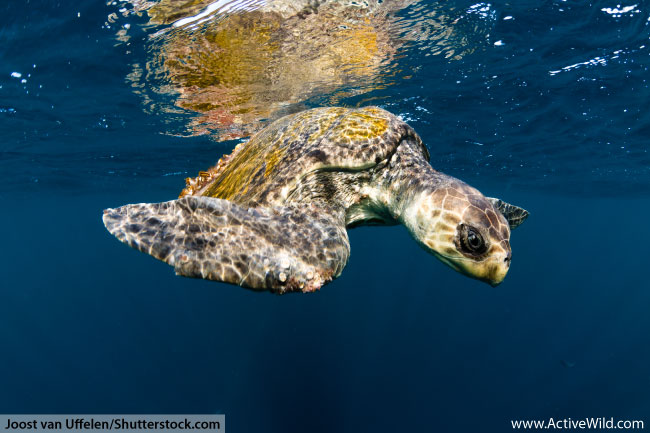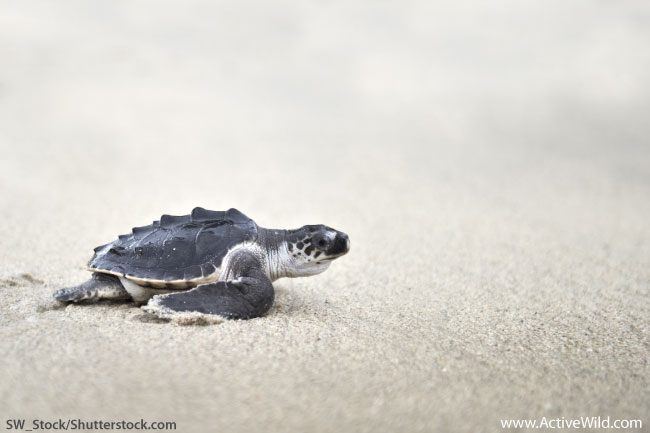This page contains amazing Olive Ridley Sea Turtle facts for kids. This animal is part of the Active Wild Online Zoo: information, pictures and videos of all your favourite animals!
- You can find out about the other types of sea turtle here: Sea Turtle Facts
Olive Ridley Sea Turtle Facts At A Glance
- Other Names: Pacific Ridley Sea Turtle
- Latin name: Lepidochelys olivacea
- Type of Animal: Reptile, Sea Turtle
- Animal Family: Cheloniidae
- Where Found: Tropical and warm oceans all around the world, particularly the Pacific and Indian Oceans.
- Size: Shell length between 0.6 and 0.7m (1.6 to 2ft.)
- Weight: Between 36 and 50kg (80 and 110lbs), females are larger than males.
- Conservation Status: Vulnerable
Virtual Zoo: Watch Olive Ridley Sea Turtles In The Wild
Watch the video below to see the Olive Ridley Sea Turtle in the wild:
Meet The Olive Ridley Sea Turtle
Introduction
The olive ridley sea turtle is responsible for one of nature’s most amazing spectacles: the so-called 'arribada', in which thousands of turtles crawl out of the sea at the same time to lay their eggs. We’ll learn more about this further down the page!
How To Recognize An Olive Ridley Sea Turtle
The olive ridley sea turtle is one of the smaller sea turtles. It has a rounded, heart-shaped shell, or ‘carapace’. The shell is an olive-green color, which is how the turtle got its name. (Where the ‘ridley’ part of the name came from remains a mystery!)
Diving
The olive ridley will dive to around 150m (492ft.) to find food on the sea bed. Sea turtles don’t have gills like fish, and need to come up to the surface to breathe.
Boy Or A Girl?
The male olive ridley sea turtle is smaller than the female, and its tail can be seen poking out from the back of its shell.
What Do Olive Ridley Sea Turtles Eat?
The olive ridley’s diet consists of jellyfish, tunicates (invertebrates that attach themselves to rocks), crabs, shrimp and other small sea creatures. It is an omnivore, and will eat algae when other food is scarce.
Olive Ridley Sea Turtle Arribadas
The olive ridley spends most of the year alone, and during this time may travel thousands of miles to its feeding grounds. Every year, however, it will migrate back to the area in which it was born in order to breed.
Males and females meet offshore. The female then returns to the very same beach on which she hatched in order to lay her eggs.
Hundreds, and sometimes thousands, of female olive ridleys emerge from the ocean at the same time. These mass arrivals are known as ‘arribadas’, and are a well-known natural spectacle.
Famous arribadas take place on Gahirmatha Beach in the Indian state of Odisha, and Nancite and Ostional beaches in Costa Rica. Others occur in Nicaragua, Mexico and Sri Lanka.
After clambering up the sandy beach, the female turtle digs a hole into which she lays between 100 and 120 eggs. She then covers the eggs with sand and returns to the sea.
Female turtles sometimes do this twice, or even three times, in a breeding season.
The eggs begin to hatch around 7 weeks later. The hatchlings, guided by the reflected light of the stars and moon on the water, crawl down the beach and into the sea.
The olive ridley doesn’t always join an arribada; it also nests alone. The olive ridley reaches sexual maturity at around 15 years old.
Is The Olive Ridley Sea Turtle Endangered?
The olive ridley is rated ‘Vulnerable’ by the IUCN.
There are more olive ridley sea turtles than any other type of sea turtle; according to estimates there are around 800,000 olive ridleys alive today. However, the current olive ridley population is a fraction of what it once was, and continues to decline. This is due to a number of reasons:
- The turtle’s eggs are considered a delicacy, and are collected and sold by locals. The turtles themselves are also hunted for their meat.
- Sea turtles often drown after getting caught up in fishing nets, even when they aren’t being targeted by the fishermen. This is known as ‘bycatch’.
- The beaches on which olive ridley turtles lay their eggs are being developed, making them unsuitable for nesting.
Olive Ridley Sea Turtle Facts For Kids: Questions
Q1. What type of animal is the Olive Ridley Sea Turtle?
- a) Reptile
- b) Mammal
- c) Lizard
Q2. How many eggs does the olive ridley turtle lay in one nest?
- a) 10 to 20
- b) 100 to 120
- c) 250 to 300
Q3. Where are olive ridleys most likely to be found?
- a) Arctic ocean
- b) Southern Ocean near Antarctica
- c) Tropical and subtropical areas
(Answers at bottom of page.)
Find Out More About Sea Turtles At Active Wild!
- You can find out more about sea turtles on this page: Sea Turtle Facts
- Discover amazing turtle species from all around the world on this page: Types of Turtles
- Find out more about turtles on this page: Is a Turtle a Reptile... and Why?
- Visit this page to become a reptile expert: Reptiles - The Ultimate Guide
Discover other sea turtle species:
- Flatback Sea Turtle Facts
- Green Sea Turtle Facts
- Hawksbill Sea Turtle Facts
- Kemp’s Ridley Sea Turtle Facts
- Leatherback Sea Turtle Facts
- Loggerhead Sea Turtle Facts
See pictures and facts about amazing animals from all around the world here: A to Z Animals
Now see more amazing animals in the Active Wild Online Zoo!
Visit a world-class zoo ... without leaving your home! At the Active Wild Online Zoo you'll find FREE pictures, facts and information on the world's most incredible animals. Each page also features a specially chosen video, and a list of questions to test your knowledge!
See other animals in the online zoo now!
Olive Ridley Sea Turtle Facts For Kids: Answers
Q1) A, Q2) B, Q3) C



